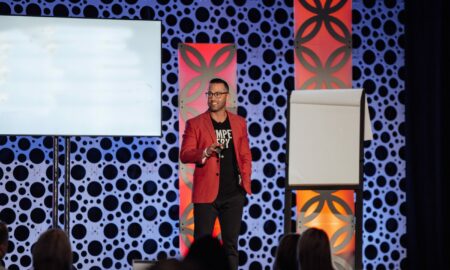 Today we’d like to introduce you to Jared Pope.
Today we’d like to introduce you to Jared Pope.
Jared, let’s start with your story. We’d love to hear how you got started and how the journey has been so far.
FOUNDATIONAL BELIEFS:
I grew up in Granbury, Texas with a single mom (Sharon), an older brother (Jimmie), and my twin brother (Zach). Given our circumstances, we always needed to find ways to help financially for the family. For my part, I washed dishes at The Cuckoo’s Nest, painted and stained boat decks around town with Zach and worked long evening hours laying grass. I even ran my own lawn business with a family friend. Finding ways to help others while working has always been a part of my life and looking back at this time, I realized there was a desire to do my own “thing.”
After high school, I attended TCU and ran track-n-field and cross-country for the Horned Frogs. After my freshman year, my desire to do my own “thing” surfaced. Instead of heading back home for the summer, I sold educational books door-to-door with the Southwestern Company.
You see, selling books door-to-door laid the groundwork for everything else with one guiding principle that I learned very well: control what you can control and don’t worry about anything else. After knocking on doors for 12 weeks in Russellville Arkansas, I ended up in the top 5% of first-time booksellers. Naturally, I sold books for three more summers and recruited by best friend and twin brother, Zach, to sell with me.
The key to selling books each summer was making sure I knocked on at least 30 doors per day. If I did this one thing and controlled what I could control, I knew the “yes” would eventually show up! You see, I could not control whether someone said yes or not, however, I could control my attitude and how hard I worked each day.
It was this time knocking on doors and running my own book-business that laid the additional framework and skills to venture into other businesses.
TESTING MY FOUNDATION:
After TCU and three summers selling books, I attended law school at SMU, where I met my wife Jennifer who was also attending law school at SMU. During the summers of legal studies, I worked various jobs, including a summer internship at Lincoln Property Company and an externship at American Airlines, as well as a boutique litigation firm.
However, it was my time studying tax law with Professor Christopher Hanna that got me intrigued with ERISA, benefits and income tax law. Although I was accepted to attend the University of Florida’s LLM in Tax program, I took a job at KPMG in the ERISA, Benefits and Compensation section.
Not too long after working at KPMG, and only two days after getting engaged with Jennifer, I found out that the Department of Justice required KPMG to shut down it’s ERISA, Benefits and Compensation, giving me just six months to find a new job. Going back to my foundation of “controlling what you can control and don’t worry about anything else,” I approached the situation as a blessing, not a setback, and knew that if I just “knocked on the doors,” I would end up in a better situation.
Fast forward to 2009, I was moved back to Dallas to be general counsel and head of compliance of a brokerage agency, Apex Global Partners (formerly Benefit Partners). From 2009 to 2011, I took my ERISA experience and built a deeper understanding of the insurance industry as a whole, as well as the business around employee benefits.
After growing the compliance department of Apex by almost 80% in two years, I decided to do my own thing and eventually started my own law firm, which allowed myself to tap into my entrepreneur spirit and desire.
MY OWN ADVENTURES:
Starting my own ERISA, benefits and HR law firm, Pope Legal Group, went off with a bang. I took my approach of “knocking on doors” and applied it to my firm and gaining clients. My goal was to have enough clients and billable hours to make what I was currently making prior my departure, which was around 50 billable hours per month. By the fourth month I greatly surpassed my goal, hitting 220 billable hours per month.
Yes, it was great revenue, but it also took me away from my interest in creating other companies! So, I recruited other ERISA-based attorneys to help with the workload in order to allow me to “knock” on other ventures. While practicing law and running a practice focused on human resources, ERISA, benefits and employment matters, I was able to learn about business, startups, healthcare, insurance and what makes a company successful.
I went on to found a healthcare data integrator for self-funded employers, carriers and hospital systems. As is mostly the case today, there are so many disparate systems that do not talk to each other. My company, Output Health, provided what we called the “golden bus” that transferred data from one system to another seamlessly and aggregated the data together so that employers, providers, healthcare systems and carriers can truly understand what was going on with an individual and start to solve the healthcare dilemma. Today, this type of system is called population health management or “big data.”
Additionally, with my law firm practice, I gained insight by constantly learning and solving issues of what clients and entities were struggling with related to benefits, human resources, employment, and ERISA issues.
With this data, as well as seeing several inefficiencies in today’s benefits market, I focused my “control” on two other ventures. One was HR Cubed (www.hr-3.com), which I formed with a good friend of mine, Todd Kirby. HR Cubed uses an “AI” and decision-tree logic platform to simplify and commoditize the ERISA, HR and benefits industry related to customized document production and compliance answers. HR Cubed is set to launch for public consumption at the end of Q1 or beginning of Q2 in 2019.
The other was Work Shield, which is based on the #MeToo movement and designed to help employers with the issues they face involving workplace harassment.
Overall, has it been relatively smooth? If not, what were some of the struggles along the way?
As you may have noticed, getting to where we are today doesn’t happen overnight and by no means is it always a smooth road! However, when faced with these obstacles and setbacks, I have always gone back to the guiding principle – control what you can control and don’t worry about anything else!
Please tell us about The Work Shield.
LAUNCH OF WORK SHIELD:
At the beginning of the meteoric rise of #MeToo and the Harvey Weinstein debacle, I kept telling myself that there has to be a better way to protect employers and allow employees to feel comfortable with reporting incidences of workplace harassment. I also kept asking the following: What is wrong with the current system and how do we make it easier? Better? More efficient?
After researching the history and current avenues that are available to companies in handling workplace harassment, I quickly realized that to truly solve the pandemic, there are two main aspects. First – remove the employer from handling the investigative process. Second – remove the fear of reporting.
Most companies attempt to “remove the fear” by implementing “anonymous” reporting tools and ethics hotlines. And where do those complaints go? The complaints are typically reported to HR, legal or executives. Are they the right ones to handle this issue? Absolutely not. You can only remove the “fear” if you take care of the first step, which is to remove the employer.
In solving this issue, Work Shield took the “normal” outside party approach but applied a new concept to outside providers in this space: a “per employee, per month” (PEPM) approach which is common in the health, benefits and ERISA landscape. In other words, employers pay a very low PEPM fee to have the EHP Plan and Work Shield. How low? It’s less than a cup of coffee per month!
With this approach, Work Shield implemented a third-party portal and reporting system that removes the employer and allows for a culture of respect and inclusion. Does this mean there will be zero issues in any company? Of course not. There will always be those “bad” hires. But having a culture of respect will make sure that those “bad” hires do not drive company profits down by running away valuable employees and harming company culture.
With the framework of Work Shield in place, I took my ERISA experience and wrapped the whole platform into an ERISA-qualified Employer Harassment Protection Plan (the “EHP Plan”), a play on the “employee assistance plan” or “EAP,” that is common with employers, big and small.
GROWTH OF WORK SHIELD:
Work Shield was taken from an idea in November 2017 and formally launched in February 2018. After building the platform, processes, operations and sales model, the EHP Plan was ready for public consumption in August 2018. We accepted our first client in September, with each month thereafter adding more.
By January 2019, Work Shield is managing a client platform of almost 2,000 employees, with an additional 10,000+ lives in contract stages for Q1 and Q2 implementation. By year-end, Work Shield is on pace to be managing 60,000+ employee lives, with annual revenues above $1M.
As I look back on my experiences, and how I’ve taken my foundational knowledge and applied to my successes (and failures), it all comes back to one guiding principle: control what you can control and don’t worry about anything else!
HOW DOES WORK SHIELD OPERATE?
From an employee perspective, an employee automatically becomes a participant in the EHP Plan. This is similar to how employers include all employees in term life insurance, where it’s automatically provided and paid for by the employer. If an employee feels he or she has experienced or sees someone else experience a workplace harassment incident, he or she files an Incident Report Form (IRF) online at www.theworkshield.com/claim-submission.
Once he or she fills out the step-by-step questionnaire, a pdf, time and date-stamped copy of his or her submission is sent to Work Shield and the attorneys to investigate the IRF. Upon receipt, Work Shield reaches out to the employee to ask any additional questions, completes the investigation, and recommends and in some cases, as applicable, implements the appropriate action.
In other words, it is not the employer who handles the investigatory process, Work Shield and its team of workplace harassment experts handle it. This allows for the removal of the employer AND the removal of fear (fear of ridicule, retaliation, job loss or the issue being swept under the rug) because the employer is removed from handling the incident. From an employer perspective, it gets the benefit of outsourcing the handling of workplace harassment issues.
When an IRF is received by Work Shield, Work Shield reviews the contents of the form, reviews the company’s applicable policies in place, conducts interviews where necessary, and then provides an assessment of the issue and a recommended response to address the issue. Work Shield and the EHP Plan allows the employer the opportunity to address the issue before a formal complaint is made with the EEOC or a related state agency. It also provides an additional benefit to an employer by providing to its employees an EHP Plan.
With that, the employer has a true administrative remedy and process to address and handle any workplace harassment issue, as opposed to a “he said, she said” issue created by verbal reporting to HR or a manager via an open-door policy. This allows the employer and the HR and legal departments to focus on other matters in the company.
Work Shield actually removes tasks from the HR and legal department desks rather than adding work to their already full plates.
WHAT SETS US APART FROM OTHERS?
Other companies trying to solve this pandemic solely focus on removing the “fear.” While that objective is great, it does not truly solve the issues. You have to remove the employer. Other systems, whether it’s an AI chatbot or digital platform, provide the compliant to the employer for the employer to investigate and handle. In other words, they do not remove the employer from handling the WHOLE situation.
Other products include the use of outside attorneys or consultants, but they charge the employer on a per hour basis or large retainer (let’s face it, attorneys are very expensive). With this in place, what normally happens is a large invoice or, the HR or legal team try to keep expenses down and handle the investigation themselves, which generally lead to mistakes, oversights and a lack of protection.
Work Shield solves all of these issues. With a low PEPM fee, we are extremely cost sensitive and lower than any other comprehensive solution that removes the fear and the employer from handling the issues. Our third-party platform allows for anonymous reporting or identification. However, what matters is that when these reports are provided, Work Shield handles the investigation and process – not the employer.
Lastly, with Work Shield and the EHP Plan, there is a definitive administrative remedy available to employees to exhaust prior to being eligible for an EEOC complaint or charge. In short, if an employee does not exhaust the EHP Plan and platform, an employer cannot be held liable (generally) based on U.S. Supreme Court rulings.
All in all, Work Shield not only provides a benefit to employees but legally protects employers!
If you had to go back in time and start over, would you have done anything differently?
I don’t know if I would do it differently, to be honest. I learned so much from my other ventures and experiences (whether successful or not) that without them, I would not be where I am today.
Yes, there have been some stressful and hard times, but my faith in God and belief in my foundational principle has guided me to where I am today, and where we are headed tomorrow. The lessons learned through failures and setbacks have proved far greater value than others.
I once saw a quote that said “I never lose. I either win or learn through my failures.” I think that holds true to everyone. However, if there is one thing I would change, it would be to trust my “gut” instincts better; rather than trying to rationalize certain decisions (in opposition of what my instincts are telling me)!
Pricing:
- $1.00 to $2.00 PEPM (based on employer size)
Contact Info:
- Address: 5706 E. Mockingbird Lane
Suite 115-153 Dallas, TX 75206 - Website: www.theworkshield.com
- Phone: 1.866.946.5558
- Email: hello@theworkshield.com








Getting in touch: VoyageDallas is built on recommendations from the community; it’s how we uncover hidden gems, so if you know someone who deserves recognition please let us know here.

















